The Simple VCO belongs to the same series as the Simple LFO.
It’s a very stripped down version of the Formant VCO, modified and adapted to the Eurorack format.
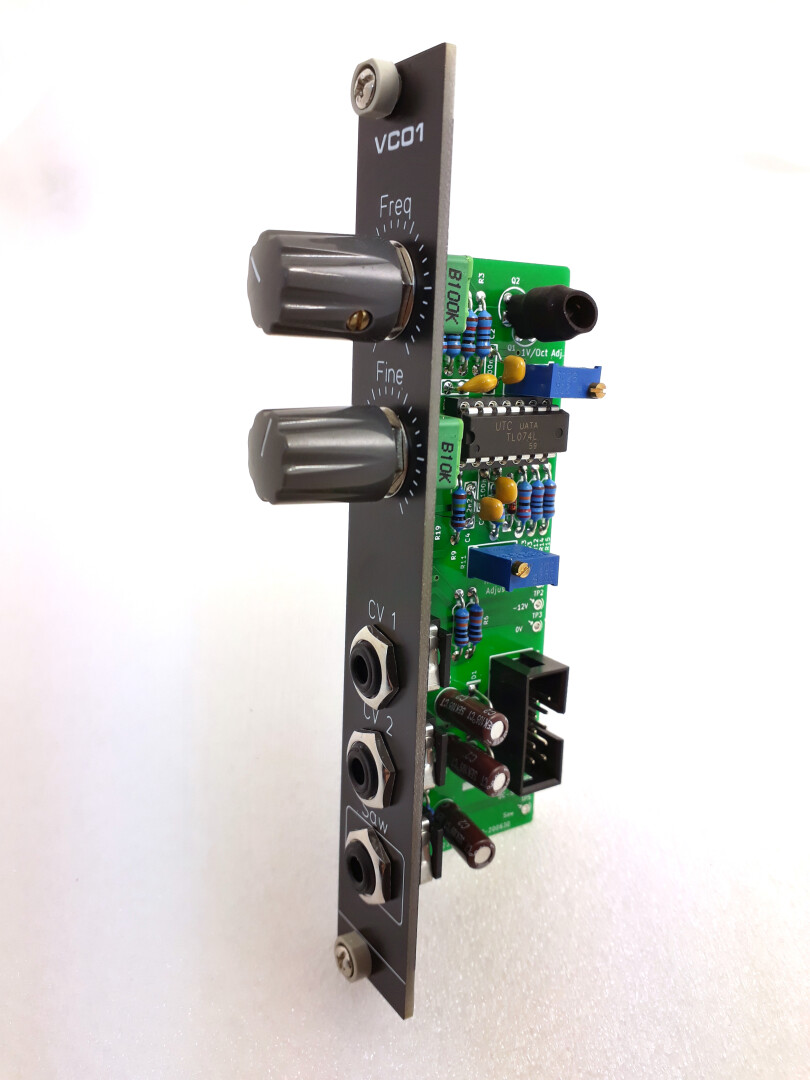
The Simple VCO is 1V/Oct capable. In order to reduce the number of parts, only one waveform output is available.
It is a super simple module, easy to build, to understand and maintain, yet fun to play and musically accurate.
Revision History
- V0.2 adds a “Fine” potentiometer. Some resistors have modified values. Check the BOM below.
- V0.2.1 : C3 Footprint changed from 2.54 to 5.08 pin pitch. This version is final and is candidate for V1.0.
- V1.0 is the first official release.
The circuit
The oscillator is a “saw core” VCO, derived from the Formant VCO. There are some differences though: the comparator is an op-amp (U1B) instead of a CMOS gate, and the switching transistor has been replaced with a simple diode (D3).
Potentiometer R2 is the main frequency control. R1 and R3 define the upper and lower limits of the base frequency range.
Potentiometer R18 is the fine frequency control. R17 and R20 define the upper and lower limits of the fine frequency range.
The frequency is modulated by 2 external Control Voltages (CV): CV1 (J1) and CV2 (J2), through R5 and R6 respectively.
U1C is a summing amplifier. It sums the CVs and R7 is the 2k temperature-compensation feedback resistor. It is located close to the matched NPN transistor pair Q1 and Q2. R8 is responsible for adjusting the 1V/Octave tracking behavior. R11 is a high frequency compensation trimmer. When the CV increases, the frequency tends to go flat. Adjusting R11 allows to get better results on higher frequencies.
C4 is the capacitor where the saw tooth signal is generated: Q2 is a current sink and discharges C4 at a constant rate. U1A follows the voltage variation and U1B compares that value to a known voltage determined by R14 and R15.
The raw saw tooth signal (DC-Saw) goes roughly from +8V to +3V. Around +3V, U1B triggers and sends a very brief positive voltage spike to the negative side of C4, through D3. This voltage variation quickly charges C4 and resets back U1B and the capacitor starts again to discharge.
It is important to note that the VCO relies at several places on the power supply rails for its voltage references. Any voltage variation on the rails will be noticeable in the frequency.
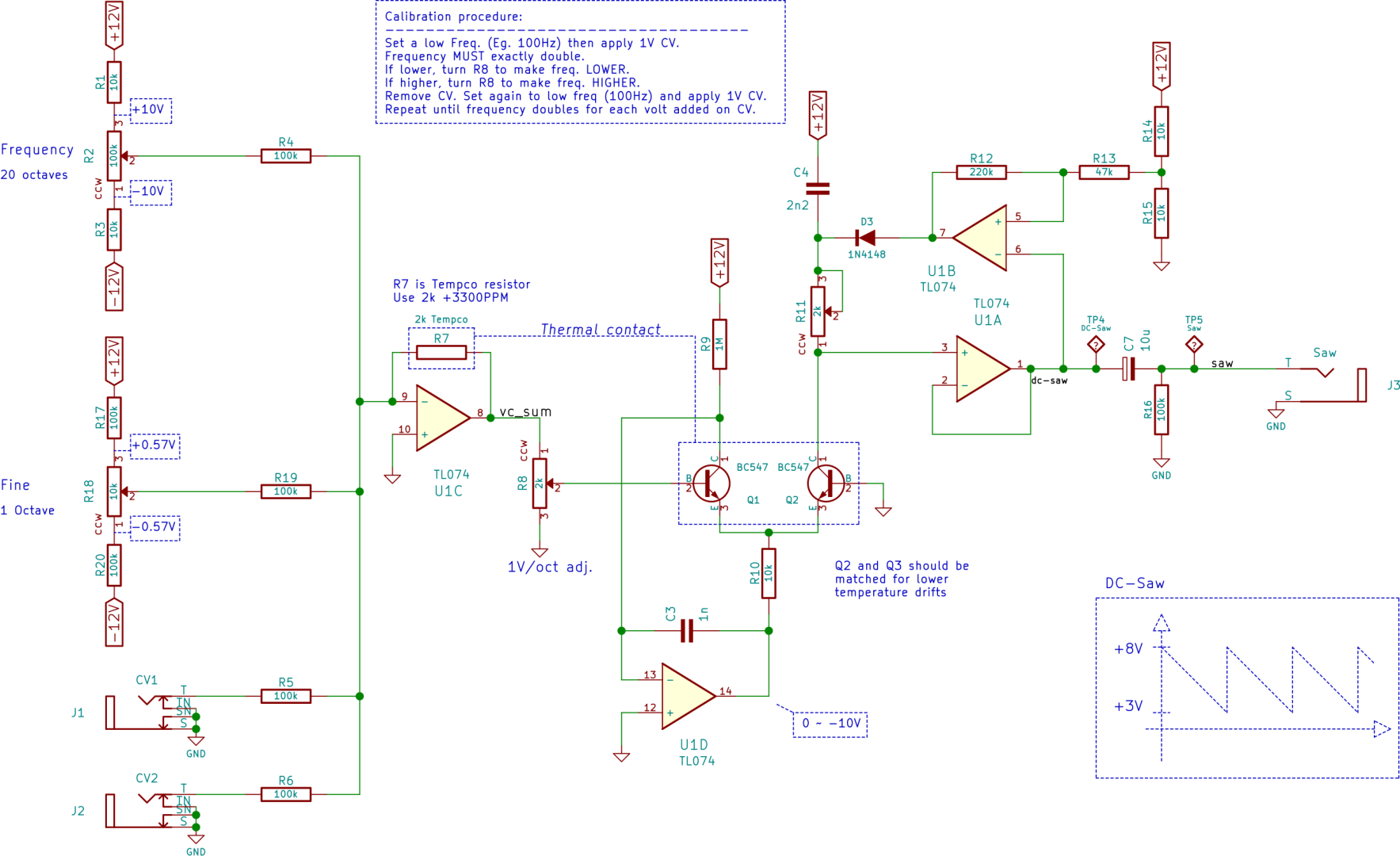
The circuit is also present in the VCO section of the DM77 Drum Module.
About the BOM
Many component values are not critical in the Simple VCO. It’s a robust circuit which can tolerate many experiments and modifications of the values.
Resistors
| References | Value | Quantity | 4-band Color Code | 5-band Color Code | |
|---|---|---|---|---|---|
| 5 | R4, R5, R6, R16, R17, R19, R20 | 100k | 7 | Brown, Black, Yellow, Gold | Brown, Black, Black, Orange, Brown |
| 6 | R1, R3, R10, R14, R15 | 10k | 5 | Brown, Black, Orange, Gold | Brown, Black, Black, Red, Brown |
| 8 | R7 | 2k Tempco | 1 | Red, Black, Red, Gold | Red, Black, Black, Brown, Brown |
| 9 | R9 | 1M | 1 | Brown, Black, Green, Gold | Brown, Black, Black, Yellow, Brown |
| 10 | R12 | 220k | 1 | Red, Red, Yellow, Gold | Red, Red, Black, Orange, Brown |
| 11 | R13 | 47k | 1 | Yellow, Violet, Orange, Gold | Yellow, Violet, Black, Red, Brown |
See Resistor color code chart.
Tempco R7
R7 is a 2k Ohms, 3300PPM Positive Temperature Compensation Resistor. It’s not a NTC (Negative Temperature Compensation).
If you can’t get a proper Positive Tempco, you can simply use a plain resistor. However, 1V/Oct tracking might drift due to temperature changes.
C5 and C6
The 2 input capacitors C5 and C6 can have any value between 1µF and 100µF. A common value is 10µF. One important thing is the minimal operating voltage of C5 and C6: it mustn’t go below 25V.
Potentiometers:
(Links might not work, please let me know.)
About the diodes D2 and D3
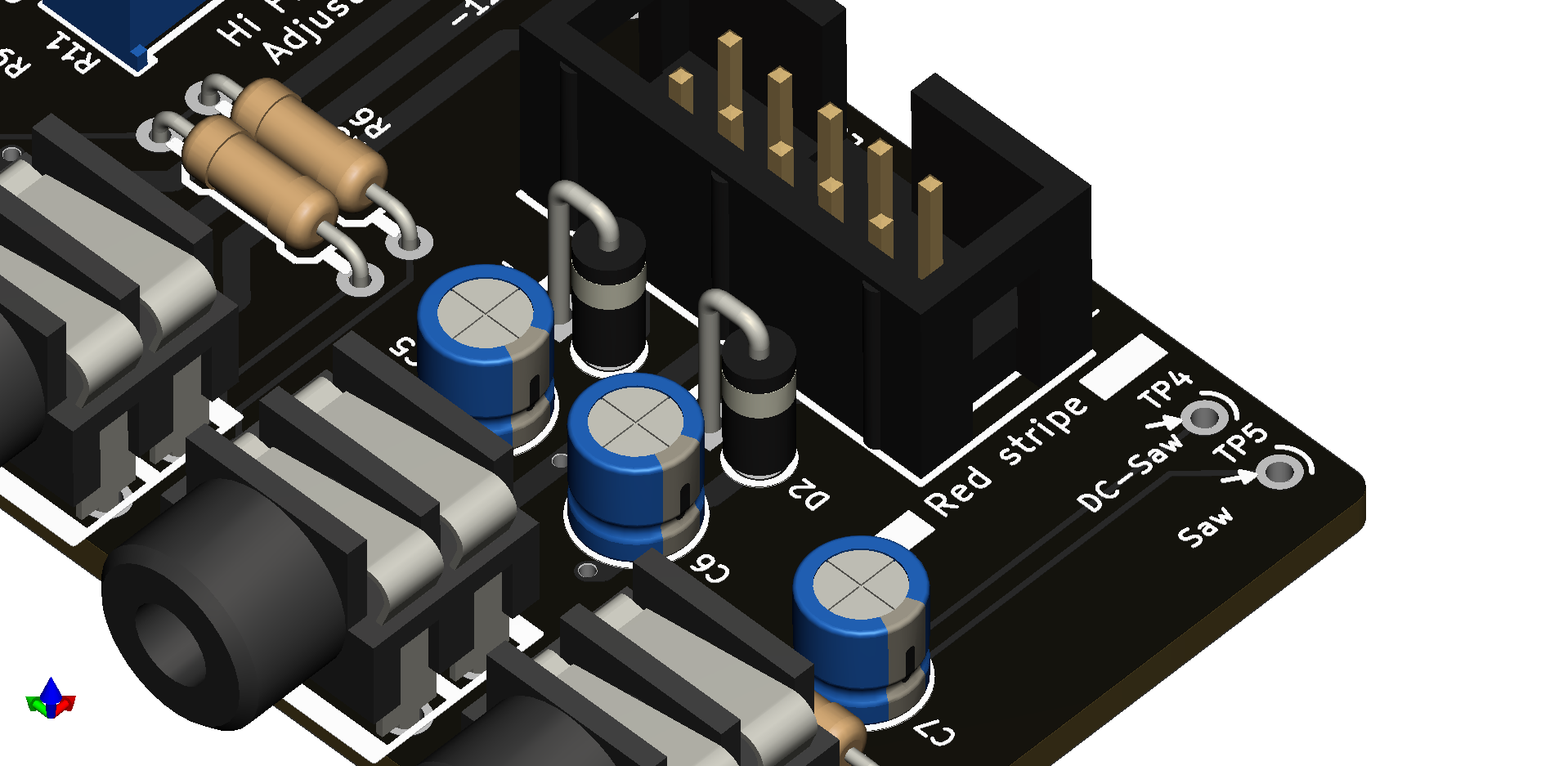
D2 and D3 are Protection Diodes: they protect against reversed voltages on the power connector. You can override the diodes with shortcuts (jumper wires or clipped legs from components).
They are to be mounted vertically, over the circle printed on the PCB, with their Cathode pin pointing Up. The Cathode side of the diode is the one with the white ring.
In other words, the Cathode must be connected to the square pad while the Anode is connected to the round pad.
Calibration and first tests
Powering on
Once you think you’ve soldered everything correctly, and before powering your module for the first time, check TWICE that you haven’t put anything backward and that the power input connector is correctly oriented, and your power cable is trust worthy!
Then, CHECK AGAIN!
Furthermore, I recommend to power the module the first time without any IC inserted and check, with a multimeter, the presence of the expected voltage rails on the correct pins.
VCO calibration
The calibration process is identical to any other VCO. The 10 turn trim potentiometer R8 sets the 1V/Octave conformance.
The second 10 turn trim potentiometer, R11, is the setting for the high frequency compensation.
The required tools are:
- An accurate voltage source, capable of delivering a CV in 1V steps (0V, 1V, 2V, etc.) CV Keyboard or MIDI to CV module.
- A frequency meter or a tuner.
- A small flat blade screw driver.
- Your tongue at righ angle and some patience.
- Also a multimeter, because you always need a multimeter.
- And if you have an oscilloscope, it’s a good idea to monitor the waveforms.
R11 must be set first to the lowest resistance between pin 1 and 3. It’s in full Counter Clockwise position.
You can also read the oscillator frequency from Test Points TP4 and TP5.
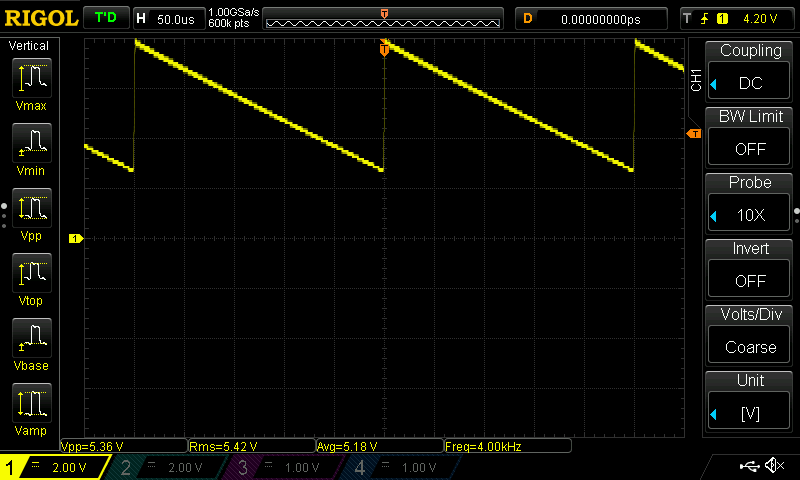
- The first step is to apply no CV input (0V) and turn the potentiometers R2 and R18 to set the oscillator frequency at a low value. If you use a frequency meter, you can set the frequency to an easy-to-read value of 100Hz, for example. If you’re using a tuner, or your ears, tune the oscillator to precisely A2 (110Hz).
- Then apply a 1V source on the CV input. The frequency of the oscillator should double (200Hz or A3). If the frequency is flat, then adjust the trim potentiometer R8 and make the frequency go a bit flatter. If the frequency is sharp, then adjust R8 to set the frequency a bit sharper.
- Go back to 0V on CV input. Now the frequency is no more 100Hz (or A2). Adjust R18 back to 100Hz precisely (or A2).
- Repeat step 2, until the frequency doubles exactly when 1V is applied to the CV input.
- You can then check if the VCO frequency doubles again with a CV at 2V. The frequency must be 4x the base frequency (400Hz or A4).
- Do the same for 3V, 4V, etc. The frequency must double for each volt added on the CV input.
- At a certain point, the frequency will start to flatten, no matter how precisely you tuned the VCO on the lower octaves. You now need to adjust the second trim potentiometer R11. Turn clockwise R11 to increase the frequency. Once you’re back in tune, return to step 2 and start over again.
After a number of iterations, the VCO is able to stay in tune for several octaves. The number of in-tune octaves depends on several factors. The quality of the transistors, among others. The matching of the transistors has no relation to how well the VCO will track. It only corrects the frequency drifts caused by temperature changes.
Drawings and dimensions

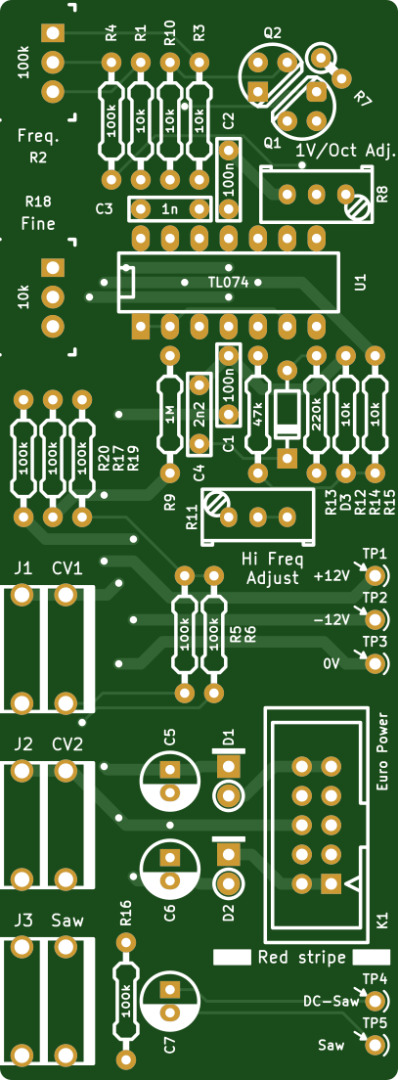
Videos
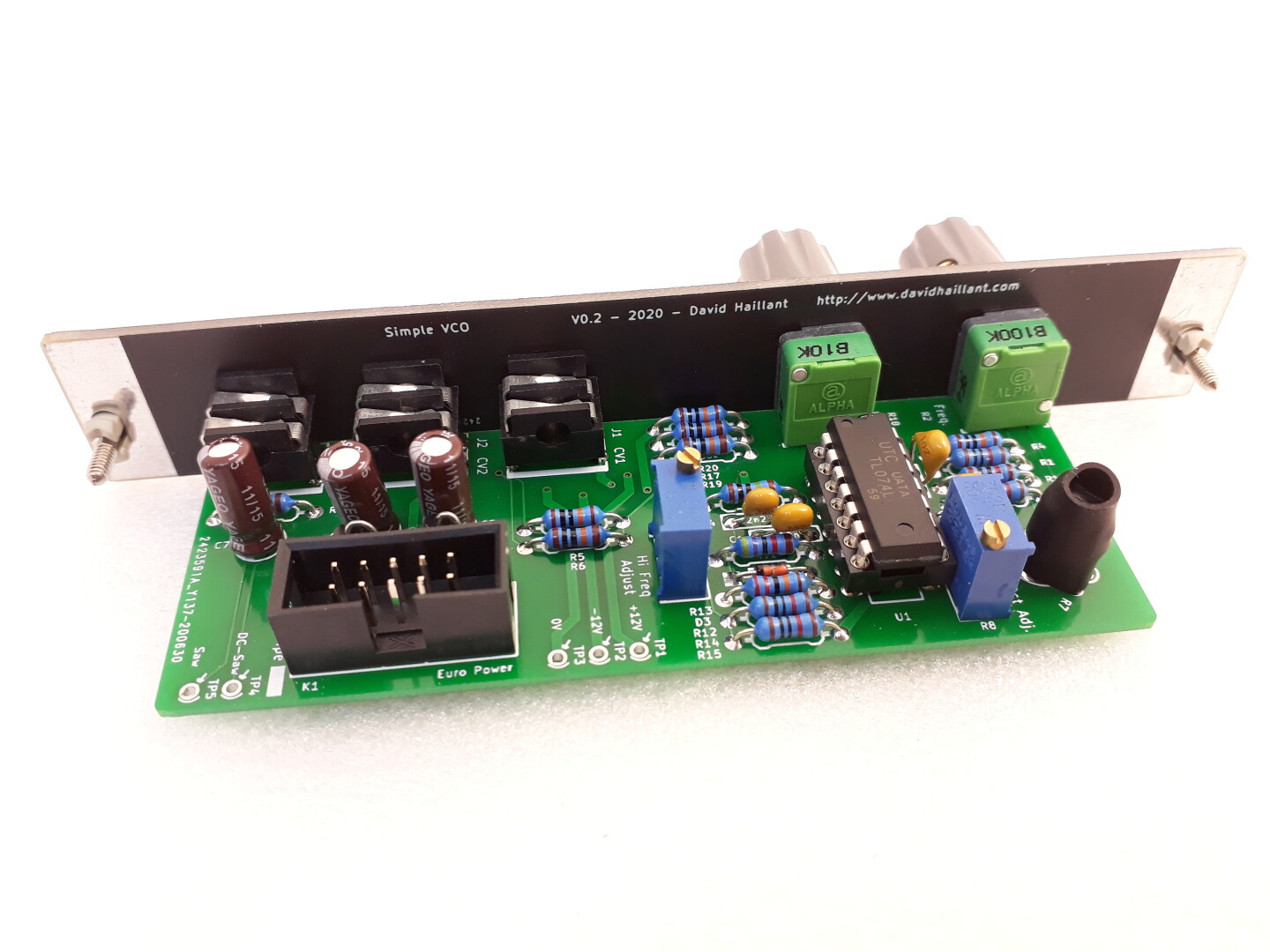
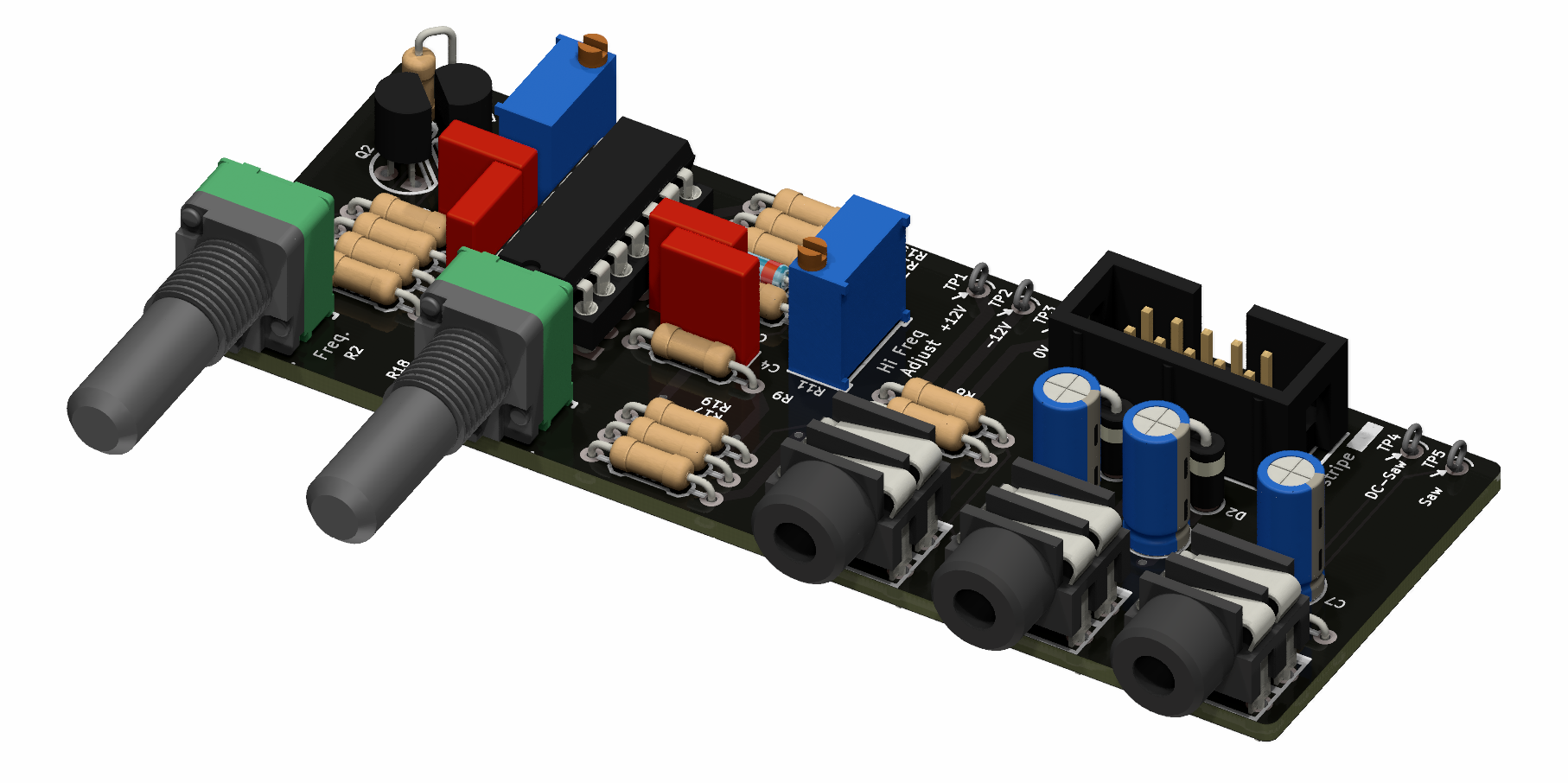
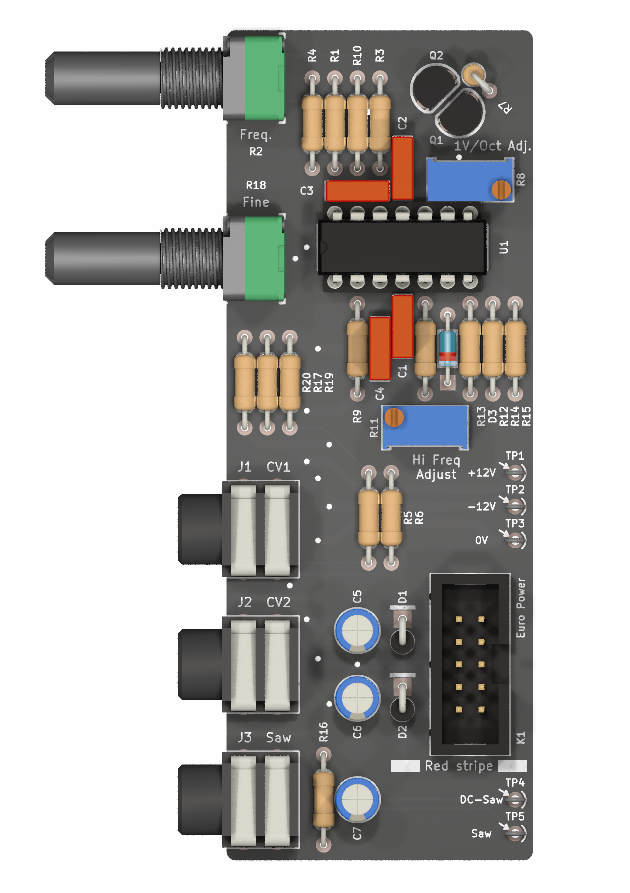

Hey David, just wanted to express my sincerest appreciation of your schematics and diagrams. The lables spacing and contrast of the screenprints and traces on your pcbs are so easy to read. Its really an art what has been achieved here. I keep returning to this one as a reference for what a working build looks like.
Thank you so much Zachary for your kind words!
I wish you a lot of fun with your synthesizer!
Hi David, I finished this VCO using the information that you provided. It looks great to me. Thank you for all the schematics and documents that you provided here. Check it out follow the link. Not sure if the link will work or not. Thought I go ahead and try it.
https://drive.google.com/drive/folders/1OK748bwxE8mculjbb3cxv6nzP5YdIH4X?usp=drive_link